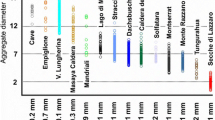Abstract
A large proportion of solid material transported within the atmosphere during volcanic eruptions consists of particles less than 500 μm in diameter. The majority of these particles become incorporated into a wide range of aggregate types, the aerodynamic behaviour of which has not been determined by either direct observation or in the laboratory. In the absence of such data, theoretical models of fallout from volcanic plumes make necessarily crude assumptions about aggregate densities and fall velocities. Larger volcanic ejecta often consists of pumice of lower than bulk density. Experimental data are presented for the fall velocities of porous aggregates and single particles, determined in systems analogous to that of ejecta falling from a volcanic plume. It is demonstrated that the fall of aggregates may be modelled in identical fashion to single particles by using a reduced aggregate density dependent on the porosity, and a size corresponding to an enclosing sphere. Particles incorporated into aggregates attain a substantially higher fall velocity than single particles. This is due to the larger physical dimensions of the aggregate, which overcomes the effect of lower aggregate density. Additionally, the internal porosity of the aggregate allows some flow of fluid through the aggregate and this results in a small increase in fall velocity. The increase in fall velocity of particles incorporated into aggregates, rather than falling individually, results in the enhanced removal of fine material from volcanic plumes.
Similar content being viewed by others
References
Ambari A, Gauthier-Manuel B, Guyon E (1985) Direct measurement of tube wall effects on the Stokes force. Phys Fluids 28:1559–1561
Armienti P, Macedonio G, Pareschi MT (1988) A numerical model for simulation of tephra transport and deposition: Applications to May 18 Mount St. Helens' eruption. J Geophys Res 93:6463–6476
Bacon DP, Sarma RA (1991) Aggregation of dust in convective clouds initialized by nuclear bursts. Atmos Environ 25A:2627–2642
Brazier S, Davis AN, Sigurdsson H, Sparks RSJ (1982) Fall-out and deposition of volcanic ash during the 1979 explosive eruption of the Soufrière of St. Vincent. J Volcanol Geotherm Res 14:335
Bursik MI, Sparks RSJ, Carey SN, Gilbert JS (in press) The concentration of ash in volcanic plumes inferred from dispersal data. Proceedings of the First International Symposium on Volcanic Ash and Aviation Safety 1991
Carey SN, Sigurdsson H (1982) Influence of particle aggregation on deposition of distal tephra from the May 18, 1980 eruption of Mount St. Helens' volcano. J Geophys Res 87 (B8):7061–7072
Clift R, Grace JR, Weber ME (1978) Bubbles, drops and particles. Academic Press, Inc
Flude MJC, Daborn JE (1982) Viscosity measurement by means of falling spheres compared with capillary viscometry. J Phys E: Sci Instrum 15:1313–1321
Gilbert JS, Lane SJ, Sparks RSJ, Koyaguchi T (1991) Charge measurement on particle fallout from a volcanic plume. Nature 349:589–600
Harmathy TZ (1960) Velocity of large drops and bubbles in media of infinite or restricted extent. A I Ch E Journal 6:281–288
Hildreth W, Drake RE (1992) Volcán Quizapu, Chilean Andes. Bull Volcanol 54:237–283
Kittl E (1933) Estudio sobre los fenómenos volcánicos y material caído durante la erupcíon del grupo del “Descabezado” en el mes de abril de 1932. Anal Museo Nac Hist Nat (Buenos Aires) 37:321–364
Merrington AC (1949) Viscometry. Edward Arnold, London
Sarna-Wojicki AM, Shipley S, Waitt R, Dzurisin D, Wood S, Bateridge T (1980) Areal distribution, thickness and volume of downwind as from the May 18, 1980 eruption of Mount St. Helens. US Geol Surv Open File Rep 80:1078
Schumacher R, Schminke H-U (1991) Internal structure and occurrence of accretionary lapilli — a case study at Laacher See Volcano. Bull Volcanol 53:612–634
Slaughter M, Hamil M (1970) Model for deposition of volcanic ash and resulting bentonite. Geol Soc Am Bull 81:961–968
Sorem RK (1982) Volcanic ash clusters: Tephra rafts and scavengers. J Volcanol Geotherm Res 13:63–71
Wilson L, Huang TC (1979) The influence of shape on the atmospheric settling velosity of volcanic ash particles. Earth Plan Sci Lett 44:311–324
Author information
Authors and Affiliations
Rights and permissions
About this article
Cite this article
Lane, S.J., Gilbert, J.S. & Hilton, M. The aerodynamic behaviour of volcanic aggregates. Bull Volcanol 55, 481–488 (1993). https://doi.org/10.1007/BF00304591
Received:
Accepted:
Issue Date:
DOI: https://doi.org/10.1007/BF00304591




